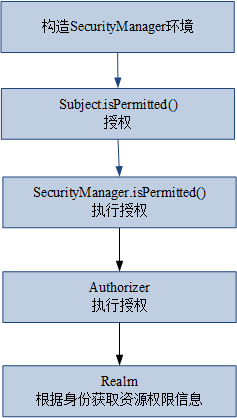1.授权流程

2 .三种授权方法
Shiro 支持三种方式的授权:
编程式:通过写if/else 授权代码块完成:
Subject subject = SecurityUtils.getSubject();
if(subject.hasRole(“admin”)) {
//有权限
} else {
//无权限
}
注解式:通过在执行的Java方法上放置相应的注解完成:
@RequiresRoles("admin")
public void hello() {
//有权限
}
JSP/GSP 标签:在JSP/GSP 页面通过相应的标签完成:
<shiro:hasRole name="admin">
<!— 有权限—>
</shiro:hasRole>
3.授权
shiro-permission.ini
#用户
[users]
#用户=密码,角色1,角色2
xuxu01=123456,role1,role2
xuxu02=654321,role1
#角色
[roles]
#角色=资源:权限
role1=user:create,user:update
role2=user:create,user:delete权限标识符号规则:资源:操作:实例(中间使用半角:分隔)
user:create:01 表示对用户资源的01实例进行create操作。
user:create:表示对用户资源进行create操作,相当于user:create:*,对所有用户资源实例进行create操作。
user:*:01 表示对用户资源实例01进行所有操作。
测试类
/*
* 用户授权测试
*/
public class AuthorizationTest1 {
@Test
public void Authorization(){
Factory<SecurityManager> factory =
new IniSecurityManagerFactory("classpath:shiro-permission.ini");
SecurityManager securityManager = factory.getInstance();
SecurityUtils.setSecurityManager(securityManager);
Subject subject = SecurityUtils.getSubject();
UsernamePasswordToken token = new UsernamePasswordToken("xuxu01","123456");
try {
subject.login(token);
} catch (AuthenticationException e) {
e.printStackTrace();
}
System.out.println("用户认证:"+subject.isAuthenticated());
//授权 基于角色授权 基于资源的授权
//基于角色授权
//单个授权
boolean permitted = subject.hasRole("role1");
System.out.println("单个角色授权:"+permitted);
//多个
permitted = subject.hasAllRoles(Arrays.asList("role1","role2"));
System.out.println("多个角色授权:"+permitted);
//和上面返回true false不同 这里如果没有角色会抛异常
subject.checkRole("role1");
//基于资源的授权
//单个
permitted =subject.isPermitted("user:update");
System.out.println("单个资源授权:"+permitted);
//多个
permitted=subject.isPermittedAll("user:update","user:create");
System.out.println("多个资源授权:"+permitted);
subject.checkPermission("user:update:1");
}
}结果:
用户认证:true
单个角色授权:true
多个角色授权:true
单个资源授权:true
多个资源授权:true4.自定义realm授权
shiro-permission-myrealm.ini
[main]
#自定义realm
myRealm=com.xuxu.realm.MyRealmPermission
#将myRealm设置进securityManager 相当于spring中注入自定义realm
securityManager.realms=$myRealmMyRealmPermission
public class MyRealmPermission extends AuthorizingRealm{
/*
* 用户自定义授权
*/
@Override
protected AuthorizationInfo doGetAuthorizationInfo(PrincipalCollection principals) {
String principal = (String) principals.getPrimaryPrincipal();
//根据传入凭证 principal 数据库查询权限
List<String> permissions = new ArrayList<String>();
permissions.add("user:creat");
permissions.add("user:update");
SimpleAuthorizationInfo authorizationInfo = new SimpleAuthorizationInfo();
authorizationInfo.addStringPermissions(permissions);
return authorizationInfo;
}
@Override
protected AuthenticationInfo doGetAuthenticationInfo(AuthenticationToken token) throws AuthenticationException {
//第一步从token中取出身份信息(token代表用户输入的传下来的信息)
String userName = (String) token.getPrincipal();
//第二步:根据用户输入的userCode从数据库查询
//数据库中通过名称查询出对应的用户信息
//判断数据库中查出用户是否为空
//假设数据库中查出用户账号密码为
String name = "xuxu01";
String password="123456";
SimpleAuthenticationInfo authenticationInfo =
new SimpleAuthenticationInfo(name, password, this.getName());
return authenticationInfo;
}
}用户授权测试
/*
* 用户授权测试
*/
public class AuthorizationTest2 {
@Test
public void Authorization(){
Factory<SecurityManager> factory =
new IniSecurityManagerFactory("classpath:shiro-permission-myrealm.ini");
SecurityManager securityManager = factory.getInstance();
SecurityUtils.setSecurityManager(securityManager);
Subject subject = SecurityUtils.getSubject();
UsernamePasswordToken token = new UsernamePasswordToken("xuxu01","123456");
try {
subject.login(token);
} catch (AuthenticationException e) {
e.printStackTrace();
}
//用户认证成功
System.out.println("用户认证:"+subject.isAuthenticated());
boolean permitted = subject.isPermitted("user:update");
System.out.println("单个权限验证:"+permitted);
permitted = subject.isPermittedAll("user:creat","user:update");
System.out.println("多个权限验证:"+permitted);
try {
subject.checkPermission("user:update");
} catch (Exception e) {
e.printStackTrace();
}
}
}
结果

将上诉中user:update 改为user:delete
结果
用户认证:true
DEBUG [main] - No authorizationCache instance set. Checking for a cacheManager...
DEBUG [main] - No cache or cacheManager properties have been set. Authorization cache cannot be obtained.
单个权限验证:false
DEBUG [main] - No authorizationCache instance set. Checking for a cacheManager...
DEBUG [main] - No cache or cacheManager properties have been set. Authorization cache cannot be obtained.
DEBUG [main] - No authorizationCache instance set. Checking for a cacheManager...
DEBUG [main] - No cache or cacheManager properties have been set. Authorization cache cannot be obtained.
多个权限验证:false
DEBUG [main] - No authorizationCache instance set. Checking for a cacheManager...
DEBUG [main] - No cache or cacheManager properties have been set. Authorization cache cannot be obtained.
org.apache.shiro.authz.UnauthorizedException: Subject does not have permission [user:delete]
at org.apache.shiro.authz.ModularRealmAuthorizer.checkPermission(ModularRealmAuthorizer.java:323)5.执行流程
1、对subject进行授权,调用方法isPermitted("permission串")

2、SecurityManager执行授权,通过ModularRealmAuthorizer执行授权


3、ModularRealmAuthorizer执行realm(自定义的CustomRealm)从数据库查询权限数据
调用realm的授权方法:doGetAuthorizationInfo
4、realm从数据库查询权限数据,返回ModularRealmAuthorizer

5、ModularRealmAuthorizer调用PermissionResolver进行权限串比对
6、如果比对后,isPermitted中"permission串"在realm查询到权限数据中,说明用户访问permission串有权限,否则 没有权限,抛出异常。
